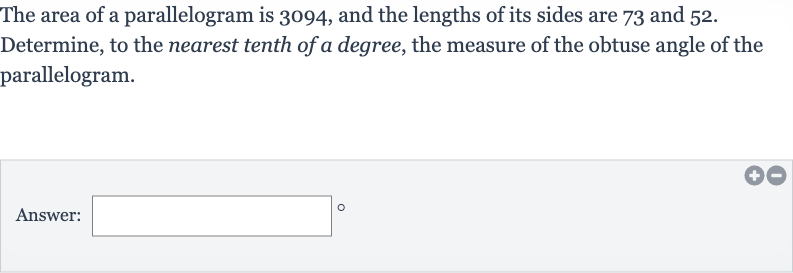Full solution
Q. The area of a parallelogram is , and the lengths of its sides are and . Determine, to the nearest tenth of a degree, the measure of the obtuse angle of the parallelogram.Answer:
- Understand Area Formula: To find the measure of the obtuse angle, we first need to understand the formula for the area of a parallelogram, which is given by the product of its base and height . We have the area and the length of one side (which we can consider as the base, ). However, we do not have the height directly, but we can calculate it using the area formula.
- Calculate Height: Let's calculate the height of the parallelogram using the area formula . Rearranging the formula to solve for height, we get .
- Use Trigonometry for Angle: Now, we plug in the values we have:
- Find Acute Angle: Performing the division, we get , which we can round to for simplicity in further calculations.
- Find Obtuse Angle: The height we've calculated is the altitude of the parallelogram, which is perpendicular to the base. To find the obtuse angle, we need to use the relationship between the sides and the height, which involves trigonometry. Specifically, we can use the cosine of the angle, where . In this case, the adjacent side is the height, and the hypotenuse is the other given side length ( cm).
- Find Obtuse Angle: The height we've calculated is the altitude of the parallelogram, which is perpendicular to the base. To find the obtuse angle, we need to use the relationship between the sides and the height, which involves trigonometry. Specifically, we can use the cosine of the angle, where . In this case, the adjacent side is the height, and the hypotenuse is the other given side length ( cm).We can rearrange the cosine formula to solve for the angle: . Plugging in the values, we get .
- Find Obtuse Angle: The height we've calculated is the altitude of the parallelogram, which is perpendicular to the base. To find the obtuse angle, we need to use the relationship between the sides and the height, which involves trigonometry. Specifically, we can use the cosine of the angle, where . In this case, the adjacent side is the height, and the hypotenuse is the other given side length ( cm).We can rearrange the cosine formula to solve for the angle: . Plugging in the values, we get .Using a calculator, we find the acute angle to be degrees. However, we are asked for the obtuse angle, which is supplementary to the acute angle we just found. The sum of angles in a parallelogram is degrees for any two adjacent angles.
- Find Obtuse Angle: The height we've calculated is the altitude of the parallelogram, which is perpendicular to the base. To find the obtuse angle, we need to use the relationship between the sides and the height, which involves trigonometry. Specifically, we can use the cosine of the angle, where . In this case, the adjacent side is the height, and the hypotenuse is the other given side length ( cm).We can rearrange the cosine formula to solve for the angle: . Plugging in the values, we get .Using a calculator, we find the acute angle to be degrees. However, we are asked for the obtuse angle, which is supplementary to the acute angle we just found. The sum of angles in a parallelogram is degrees for any two adjacent angles.To find the obtuse angle, we subtract the acute angle from degrees: .
- Find Obtuse Angle: The height we've calculated is the altitude of the parallelogram, which is perpendicular to the base. To find the obtuse angle, we need to use the relationship between the sides and the height, which involves trigonometry. Specifically, we can use the cosine of the angle, where . In this case, the adjacent side is the height, and the hypotenuse is the other given side length ( cm).We can rearrange the cosine formula to solve for the angle: . Plugging in the values, we get .Using a calculator, we find the acute angle to be degrees. However, we are asked for the obtuse angle, which is supplementary to the acute angle we just found. The sum of angles in a parallelogram is degrees for any two adjacent angles.To find the obtuse angle, we subtract the acute angle from degrees: .Performing the subtraction, we get the obtuse angle degrees.
More problems from Convert between customary and metric systems
QuestionGet tutor help
QuestionGet tutor help
QuestionGet tutor help
QuestionGet tutor help
QuestionGet tutor help
QuestionGet tutor help

